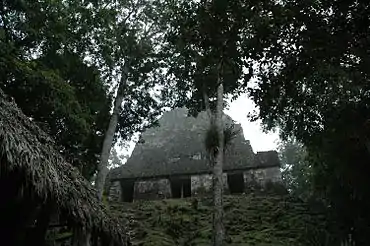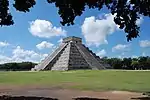Tikal Temple VI
Tikal Temple VI (also known as the Temple of the Inscriptions and Structure 6F-27)[1] is a Mesoamerican pyramid in the ruins of the major Maya city of Tikal, in the Petén department of northern Guatemala. Temple VI is located at the southeastern end of the Mendez Causeway, which links the temple plaza with the site core.[2] The temple faces west onto a walled plaza.[3] The existence of the temple was first reported in 1951 by Antonio Ortiz on behalf of the Instituto de Antropología e Historia (IDAEH - "Institute of Anthropology and History").[4] The roof comb of the temple is inscribed on its sides and back with a lengthy hieroglyphic text. The pyramid's summit superstructure contains two chambers,[3] and the highest surviving portion of the temple's roof comb stands 12 metres (40 ft) high.[6] The pyramid superstructure is accessed via three west-facing doorways.[7] The triple doorway and interior layout of the chambers suggest that Temple VI was in fact a palace-type structure rather than a temple.[8]

Hieroglyphic inscription
The text contains a history of Tikal stretching back into the Preclassic period. The earliest date in the text equates to 1139 BC; it records either a mythical foundation event or, perhaps, a distantly remembered historical event of importance.
Monuments
 |
| Maya civilization |
|---|
| History |
| Preclassic Maya |
| Classic Maya collapse |
| Spanish conquest of the Maya |
Stela 21 was erected at the foot of Temple VI. It records the succession of king Yik'in Chan K'awiil in AD 734.[10] When found the stela had fallen from its original position and was re-erected during restoration work.[3] Only the bottom section of the stela survives.[6] Some text survives on the left hand side of the front of the monument; it is of excellent quality workmanship and records a date in AD 736. A part of the stela was reused and fashioned into a metate that was found by locals 0.3 kilometres (0.19 mi) northwest of the temple.[3]
Altar 9 is paired with Stela 21 at the foot of the pyramid steps.[3] The altar is badly damaged and is missing large fragments.[3] The upper face of the altar was sculpted with the image of a face-down bound captive.[11]
Notes
- Sharer and Traxler 2006, p.403. Coe 1967, 1988, p.87.
- Sharer and Traxler 2006, p.306.
- Coe 1967, 1988, p.87.
- Coe 1967, 1988, p.87. Muñoz Cosme and Quintana Samayoa 1996, p.302.
- Kelly 1996, p.139.
- Coe 1967, 1988, p.87. Maldonado and Hernández 1998, p.33.
- Maldonado and Hernández 1998, p.33.
- Sharer and Traxler 2006, pp.304, 400.
- Coe 1967, 1988, .pp.87-88.
References
- Coe, William R. (1988) [1967]. Tikal: Guía de las Antiguas Ruinas Mayas [Tikal: Guide to the Ancient Maya Ruins] (in Spanish). Guatemala: Piedra Santa. ISBN 84-8377-246-9. OCLC 21460472.
- Kelly, Joyce (1996). An Archaeological Guide to Northern Central America: Belize, Guatemala, Honduras, and El Salvador. Norman: University of Oklahoma Press. ISBN 0-8061-2858-5. OCLC 34658843.
- Maldonado, Oscar; Daniel Hernández (1998). Tikal: Historia, arte y monumentos (in Spanish). Mexico City: Monclem Ediciones. ISBN 968-6434-76-3. External link in
|title=(help) - Muñoz Cosme, Gaspar; Óscar Quintana Samayoa (1996). "Intervenciones de restauración en el Templo I de Tikal, 1992–1994" [Restoration operations upon Temple I at Tikal, 1992-1994] (PDF). IX Simposio de Investigaciones Arqueológicas en Guatemala, 1995 (edited by J.P. Laporte and H. Escobedo) (in Spanish). Guatemala: Museo Nacional de Arqueología y Etnología: 302–308. Archived from the original (PDF) on 2011-09-14. Retrieved 2012-03-09.
- Sharer, Robert J.; Loa P. Traxler (2006). The Ancient Maya (6th (fully revised) ed.). Stanford, CA: Stanford University Press. ISBN 0-8047-4817-9. OCLC 57577446.
.png.webp)

